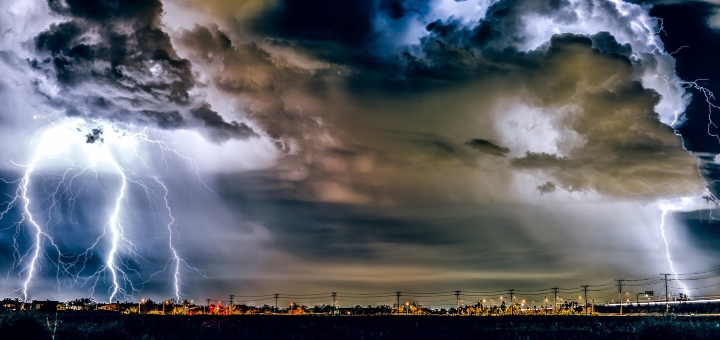Preparing businesses and homes for the effects of natural disasters

Mother Nature is known to wreak havoc on our shores at times. Fortunately, rural insurance providers Lycetts have provided advice on how homes and businesses can best prepare for a number of disasters, and how to recover from them, too.
Drought
The UK uses a huge amount of water. In fact, Water UK states that over 17 billion litres of water is delivered to the nation’s mains water supply per day. This water will cater for more than 60 million consumers, with 150 litres used by each of us on a daily basis on average.
This water will go into the UK’s mains water supply even if there is no rainfall. Therefore, a drought will officially be declared in the country if we experience 15 days of minimal wet weather – under 0.2mm of rain. In the UK, we tend to witness a drought once every five to ten years.
How to prepare
You should automatically make water conservation practices a part of your daily life. That way, you will be familiar with using less water in the scenario that water limitation measures are brought in across the country.
Consider using any spare water on indoor plants or a suitable outdoor area of your workplace instead of simply putting it down the drain after you’ve used it. An instant hot water heater should be installed onto your sink too, while dripping faucets should be repaired by replacing the washer – for this last point, bear in mind that a single drip per second will result in 2,700 gallons of water being wasted per year!
Try to plant native and drought-tolerant evergreen shrubs and trees around your property. This is because they will adapt to the local climate and not need too much water once established; not to mention often surviving a sustained dry period without watering. Mulch should also be used to retain moisture in the soil, with the added benefit being that mulch controls weeds which compete with other plants for water.
How to recover
You’ll be please to know that once a drought has passed, most of your life will quickly adjust back to normal. Any hosepipe bans which were enforced will be swiftly lifted, for instance, so that you can go back to cleaning the exterior of your property and watering plants as normal. Any restrictions on water use will be eased too, though it’s still best to keep up the water conservation practices advised above as a way of life moving forwards.
However, one area that won’t adjust so quickly is your lawn. If it’s being subjected to a drought for a long period, turf grasses may have turned brown and stopped growing completely. While most of the lawn will often recover in time with renewed rainfall, you should look to carry out renovation and repair work in the autumn for particularly problematic areas. Over-seed areas which are sparsely-grassed – this guide by the RHS will help – and refrain from using lawn weed killers on turf that has been affected by drought throughout the autumn.
In The Environment Agency’s Drought response: our framework for England report, the organisation states: “Once a drought recedes, it’s important to continue environmental monitoring to assess recovery of sites and identify any long-term environmental damage. Our area analysis and reporting teams are responsible for establishing and carrying out a drought recovery monitoring programme. Drought monitoring will normally continue until the ecology has recovered to normal conditions.”
Flooding
Recently, Britain has been subjected to more frequent flooding. Between November 2015 and January 2016, for instance, the UK experienced the most ever rainfall for that date period. Not too earlier than that, the wettest winter on record for the UK was recorded during the winter of 2013/14.
How to prepare
Due to information in the media, there should be plenty of time for you to prepare for potential flooding. This page of GOV.UK should also be monitored, as it informs you if your area is either at an immediate risk of flooding, at risk anytime in the next five days, or is seen to be a long-term risk area.
Is your area likely to be flooded? If so, you should get an emergency kit prepared (there are different ones for when you’re at a facility, on the move, or in your car, which Red Cross details here), and purchase some sand and sandbags in good time – these are likely to be in high demand once a flood strikes.
You may have been advised to vacate your location, too. Before doing so, ensure you have switched off the mains power so that there is no risk of being electrocuted from floodwater, and shut and locked every window and door to protect your property and give an extra barrier from floodwater getting inside. Take up-to-date photographs around the interior of your workplace too, as they may prove very useful in the event you need to make an insurance claim.
How to recover
Disposing of any food that has been in floodwater is crucial, since floodwater is at risk of being contaminated with sewage. Until your water supply company gives your tap water the all clear, you should only boil tap water or use bottled water. Your water company should be contacted if your tap water’s colour, smell or taste has changed as well. Gas or electrical items should also not be switched on until they have been checked by a qualified technician, as they may have got wet during a flood.
Contact your insurance company as soon as possible following flooding. Make sure to take photographs ahead of starting any cleaning up too – which can be coupled with the photos taken when preparing for a flood as a before and after snapshot – and only discard any items once they’ve been cleared by your insurer.
Storms
Storms too are becoming more common in Britain. Between 12 September 2017 and 24 January 2018 alone, there were nine named storms across the UK. Many people are sure to still have the ‘Beast from the East’ fresh in their minds too, where a mixture of blizzards, drifting snow, strong winds and bitterly cold temperatures caused huge problems and resulted in the Met Office issuing a rare red weather warning – the organisation’s most severe alert.
How to prepare
Start with the basics. Any rubbish bins and exterior furniture should be moved indoors – perhaps in a garage or underground section of your workplace facilities – so that they are not able to cause damage to cars or surrounding property if they are blown over when a storm hits. On the topic of cars, you should move your vehicles into a garage or somewhere that is sheltered too, so that they can’t receive damage from flying debris.
Is your business surrounded by trees and tall structures? Before a storm arrives, have a look to ensure that these aren’t damaged, and are not likely to be blown over when the bad weather rolls in. If you are concerned, get in touch with your local authority, as leaving the problem may result in it damaging your property or putting people in danger. Trees and shrubs can also be trimmed to make them more wind-resistant.
Make sure you are aware of your company’s surroundings, too. Checking the elevation level of an area will let you know if it’s prone to floods, for instance, while being aware of nearby dams and levees will allow you to assess whether these could cause a hazard to you during a storm.
How to recover
It’s essential that you stay inside until it has been confirmed that the storm has passed. Even when it is safe to go outside and begin the storm clean-up process, be extra vigilant, as the wet and windy weather may have caused more damage than you can see. Trees and tall structures may now be unsafe, for example, so keep your distance until they can be accessed.
If you find that trees have fallen, don’t try to move them yourself. Report the issue and any possible obstruction they are causing to your local council. Photos and notes should also be taken of any damage that has been caused to your business from the storm, with this being followed up by a phone call to your insurer to make them aware of all issues.
Severe gales
Winds that reach between 32 and 63 miles per hour can be classed as a gale. However, the UK has been subjected to much more powerful gusts of wind over the years. On 20 March 1986, for example, a gust of 173 mph was recorded at the Cairngorm summit. It’s not just at higher levels where strong winds cause problems, though; a gust of 142 mph was recorded at Fraserburgh, in Aberdeenshire, on 13 February 1989, a wind speed of 124 mph was marked at Kilkeel in County Down on 12 January 1974, and winds of 118 mph were felt at Gwennap Head, in Cornwall, on 15 December 1979.
How to prepare
It should be common knowledge to ensure loose objects are secured well in advance of high winds. Crumbling brickwork and broken fences should also be tended to before severe gales arrive, as waiting until after the wind has eased could result in you having to fork out more money for the repairs – not to mention the issues posing risks to your property and workers based there while the gales are blowing fiercely.
Your workplace’s roof is likely to be among the areas most exposed to severe gales, so inspect it before the winds pick up. Any mould, sagging material, loose sheathing, areas which are leaking, and rusted nails should be reported to a specialist for them to rectify ahead of the problematic weather.
How to recover
When the speeds have died down, look around your workplace to check for any damage that has been caused. Attempt to make your facilities as safe as possible again too, though it’s best to leave the complicated repairs to the experts. When inspecting your property, also be on the lookout for any fallen cables, loose masonry and weakened trees, keeping your distance if any of these are identified.
Your electric connection is likely to have been lost, also. Don’t attempt to restore power yourself, but instead get in touch with your electricity supplier to make them aware of the issue and to get details about when the power will likely be restored.
It could be a good idea to phone your local council. They will endeavour to check vulnerable buildings that are undergoing extensive structural work, remove debris which has found its way onto highways, and close roads (where necessary) after severe weather has travelled across a region.
Sources
- https://www.water.org.uk/consumers/drought
- https://www.thesun.co.uk/fabulous/3849208/drought-hosepipe-ban-britain-cape-town/
- https://www.ready.gov/drought
- https://www.rhs.org.uk/advice/profile?PID=417
- https://nerc.ukri.org/planetearth/stories/1849/
- https://www.redcross.org.uk/get-help/prepare-for-emergencies/how-to-prepare-for-floods-and-flooding
- https://www.metoffice.gov.uk/barometer/uk-storm-centre
- https://www.bbc.co.uk/news/uk-24693145
- http://evaq8.co.uk/Emergency-Preparedness-Storm-how-to-prepare-for-a-storm.html
- https://www.express.co.uk/life-style/top10facts/546895/Top-10-facts-about-wind
- http://home.bt.com/lifestyle/house-home/home-hacks/gale-force-winds-how-to-protect-your-home-from-severe-weather-11364015728647
- https://www.calderdale.gov.uk/v2/council/emergencies/preparing-emergencies/be-prepared-severe-gales









